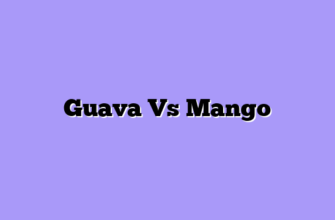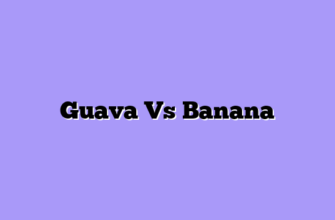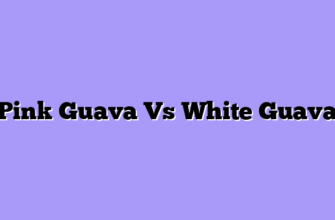Guava, a tropical fruit known for its sweet and tangy flavor, is a delightful addition to any diet. However, selecting ripe guavas can be a challenge, as their exterior doesn’t always accurately reflect their internal ripeness. One of the most reliable indicators of guava ripeness is its color. While the specific color variations can differ depending on the guava variety, there are general guidelines to follow.
Color
For instance, the common green guava, often referred to as “apple guava,” will transition from a bright green to a pale green or even a yellowish-green hue as it ripens. This color change signifies that the fruit has begun to soften and develop its characteristic sweetness. Similarly, the red guava, also known as “strawberry guava,” will progress from a deep green to a vibrant red or even a reddish-purple color as it matures. This transformation indicates that the fruit has reached its peak flavor and texture.
However, it’s important to note that color alone isn’t a foolproof indicator of ripeness. Some guavas may develop a reddish hue prematurely, while others may remain green even when fully ripe. Therefore, it’s crucial to consider other factors in conjunction with color.

Furthermore, the size and shape of the guava can offer clues about its ripeness. Generally, ripe guavas tend to be slightly larger and more rounded than their unripe counterparts. This is because the fruit expands as it matures, filling out its shape. However, it’s important to remember that size and shape can vary depending on the guava variety.
Texture
The texture of a ripe guava is a key factor in its overall appeal. A ripe guava will yield slightly to gentle pressure, indicating its soft and succulent interior. This softness is a result of the fruit’s natural ripening process, where the starches within the guava convert to sugars, resulting in a tender and juicy texture. Conversely, an unripe guava will feel firm and unyielding to the touch. This firmness is a sign that the fruit has not yet reached its peak ripeness and its starches have not fully transformed into sugars.
Beyond the overall firmness, the texture of a ripe guava can be further assessed by examining its skin. A ripe guava will have a smooth and slightly wrinkled skin, indicating that the fruit has matured and its skin has begun to soften. This wrinkling is a natural consequence of the fruit’s internal pressure decreasing as it ripens. In contrast, an unripe guava will have a smooth and taut skin, lacking the characteristic wrinkles of a ripe fruit.
The texture of the flesh is another crucial indicator of ripeness. A ripe guava will have a soft and juicy flesh that easily separates from the skin. This soft texture is a result of the fruit’s high water content, which increases as the guava ripens. The flesh will also have a slightly grainy texture, which is a natural characteristic of the fruit. An unripe guava, on the other hand, will have a firm and dry flesh that is difficult to separate from the skin. This firmness is a sign that the fruit has not yet reached its peak ripeness and its flesh has not yet developed its characteristic softness and juiciness.
In addition to the texture of the flesh, the presence of seeds can also be a helpful indicator of ripeness. A ripe guava will have soft and easily chewable seeds, while an unripe guava will have hard and crunchy seeds. This difference in seed texture is a result of the seeds softening as the fruit ripens.
Smell
A ripe guava, ready to be enjoyed, will emit a distinct, sweet fragrance. This aroma is often described as being reminiscent of honey, pear, or even a hint of citrus. The intensity of the scent will vary depending on the variety of guava, but a strong, noticeable fragrance is a good indicator of ripeness.
Conversely, an unripe guava will have a very faint or even absent aroma. This is because the volatile compounds responsible for the fruit’s fragrance are not yet fully developed. The scent may be slightly green or even slightly sour, indicating that the fruit is not yet ready for consumption.
However, it is important to note that the presence of a strong fragrance alone is not a foolproof indicator of ripeness. Some guavas may be overripe and have a fermented or alcoholic scent, which is a sign that the fruit is past its prime.
To further refine your olfactory assessment, consider the texture of the guava. A ripe guava will have a slightly soft texture, yielding to gentle pressure. The skin will also be smooth and free of any blemishes or wrinkles.
In contrast, an unripe guava will be firm and hard to the touch. The skin may be slightly green or have a dull appearance.
Ultimately, the best way to determine the ripeness of a guava is to combine both smell and touch. If the fruit has a sweet, fragrant aroma and a slightly soft texture, it is likely ripe and ready to be enjoyed.
However, if the fruit has a faint or sour scent and is firm to the touch, it is best to wait a few more days before consuming it. Patience is key when it comes to guavas, as allowing them to ripen fully will result in a more flavorful and enjoyable experience.
Sound
When a guava is ripe, its flesh softens, and the seeds within the fruit loosen. This change in texture affects the sound the fruit makes when gently squeezed. A ripe guava will produce a dull, thudding sound, similar to the sound of a ripe avocado or a soft melon. This sound is a result of the fruit’s yielding flesh and the movement of the seeds within.
Conversely, an unripe guava will produce a sharper, more hollow sound when squeezed. This is because the fruit’s flesh is still firm and the seeds are tightly packed. The sound will be similar to that of a hard apple or a green pepper.
To test the ripeness of a guava, hold the fruit in your hand and gently squeeze it with your thumb and forefinger. Apply a moderate amount of pressure, avoiding excessive force that could damage the fruit. Listen carefully to the sound the guava makes. If it produces a dull, thudding sound, it is likely ripe. If it makes a sharper, more hollow sound, it is likely unripe and should be left to ripen further.
While the sound test is a reliable indicator of ripeness, it’s important to consider other factors as well. The color of the guava can also provide clues. Ripe guavas typically have a deep green or yellow color, depending on the variety. However, color alone is not a foolproof indicator, as some varieties may turn yellow before they are fully ripe.
Additionally, the aroma of a guava can be a helpful guide. Ripe guavas have a sweet, fragrant aroma, while unripe guavas have a more neutral or slightly tart smell.
Taste
The most reliable indicator of ripeness is the guava’s color. Unripe guavas are typically green, gradually transitioning to yellow, orange, or even red as they ripen. The specific color variation depends on the guava variety. For instance, the common white guava turns yellow when ripe, while the red guava, as its name suggests, turns red. However, color alone is not always a foolproof indicator. Some varieties may develop a reddish hue even when unripe.
Another crucial factor is the guava’s texture. A ripe guava will feel slightly soft to the touch, yielding to gentle pressure. This softness indicates that the fruit has reached its peak ripeness and is ready to be enjoyed. Conversely, an unripe guava will feel firm and hard, indicating that it needs more time to ripen.
The aroma of a guava can also be a helpful indicator of its ripeness. A ripe guava will emit a sweet, fragrant aroma, often described as floral or fruity. This aroma is a result of the fruit’s natural sugars and volatile compounds developing as it ripens. Conversely, an unripe guava will have a faint or even slightly sour aroma.
Finally, the taste of the guava is the ultimate indicator of its ripeness. A ripe guava will have a sweet and tangy flavor, with a balance of sweetness and tartness. The sweetness will be pronounced, but not overpowering, while the tartness will add a refreshing touch. An unripe guava, on the other hand, will be unpleasantly sour and lack the sweetness that characterizes a ripe guava.
In conclusion, determining the ripeness of a guava involves a combination of visual, tactile, and olfactory cues. The color, texture, aroma, and taste all play a role in indicating whether a guava is ready to eat. By paying attention to these factors, you can ensure that you are enjoying the guava at its peak flavor, maximizing its sweetness and tanginess. Remember, a ripe guava is a delightful treat, offering a burst of tropical flavor that is sure to satisfy your taste buds.
Q&A
**1. What color should a ripe guava be?**
* Ripe guavas will be a vibrant green, yellow, or even red depending on the variety.
**2. How do you check the firmness of a guava?**
* Gently press the guava. A ripe guava will be slightly soft to the touch, but not mushy.
**3. What about the scent?**
* Ripe guavas have a sweet, fruity aroma. If it smells bland, it’s likely not ripe yet.
**4. Can you tell by the leaves?**
* The leaves of a guava tree will turn yellow and fall off as the fruit ripens.
**5. What if the guava is still hard?**
* You can ripen a hard guava at room temperature for a few days.Guava is ready to eat when it is soft to the touch, has a deep green or yellow color, and has a sweet aroma.








